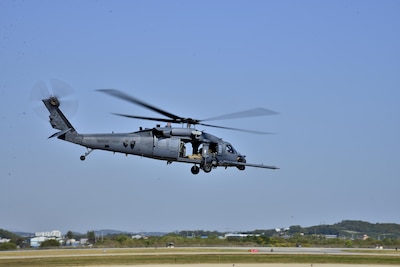By Air Force Airman 1st Class Gwendalyn Smith, 51st Fighter
Wing
PYEONGTAEK, South Korea, Oct. 24, 2017 — One of the largest
joint combat search and rescue exercises in the Pacific region, Exercise
Pacific Thunder 18-1, kicked into full swing yesterday at Osan Air Base, South
Korea.
This year, the exercise is the largest it has ever been.
More than 20 U.S. Air Force squadrons and nine South Korean air wings are
involved, giving the 25th Fighter Squadron and the 33rd and 31st Rescue
Squadrons opportunities to train in simulated combat search and rescue missions
all while working alongside their South Korean counterparts.
“Pacific Thunder originally started in 2009 as a one-week
exercise between the 25th Fighter Squadron and the 33rd Rescue Squadron, and
has since grown into a [Pacific Air Forces]-level exercise,” said Air Force
Capt. Travis Vayda, the 25th Fighter Squadron Pacific Thunder 18-1 coordinator.
Although the annual exercise now has a vast range of units
participating, it is still centered on the 25th Fighter Squadron, which
operates A-10 Thunderbolt II aircraft, and the 33rd Rescue Squadron, which
operates HH-60 Pave Hawk helicopters.
“Combat search and rescue is one of the most important mission
sets we have in the A-10 community because we are really the only fixed-wing
asset in the Air Force who trains to the CSAR mission,” Vayda said. “We are the
close muscle, so essentially we are the bodyguards of the person on the ground
and the helicopters that are rescuing them. Obviously in a CSAR [situation],
you don’t want to have another type of shoot down or anything happen.”
Realistic Training
During the exercise, the 33rd Rescue Squadron is able to
directly work with A-10 pilots from the 25th Fighter Squadron, a level of joint
training that both units typically have to simulate.
“The realism of the exercise gives us an opportunity to
really see how the 25th FS operates,” said Air Force Capt. Dirk Strykowski, the
33rd Rescue Squadron’s HH-60 Pave Hawk flight lead. “Back in Kadena, we pretend
as best we can to know what these guys are going to sound like on the radio,
what calls they’re going to make and what kind of information they are going to
provide, but being able to come up here and refresh what that’s actually going
to be like is probably the biggest take away from the exercise.”
To make the exercise even more realistic, pararescuemen and
survival, evasion, resistance and escape personnel from the 31st Rescue
Squadron are not only participating in rescue missions, but also role-playing
as isolated personnel.
“The intent of this exercise is to train like you fight, and
we are trying to replicate that as best we can,” Strykowski said. “We have a
lot of support from our pararescue and SERE. They’re out there on the ground
now pretending to be downed pilots. So every step of the way, we are making it
as realistic as it can get.”
Through combined CSAR training, exercise Pacific Thunder
enhances the combat effectiveness between U.S. and South Korean air forces.
Exercises like Pacific Thunder ensure the region remains ready to “Fight
Tonight








No comments:
Post a Comment